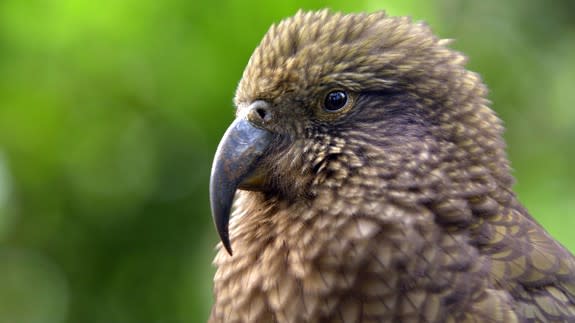Being cheeky is infectious for these parrots

If you've ever had a kea nibble your car tyre or seen the mountain parrot move a traffic cone for no earthly reason, you'd know — these cheeky birds do things just because they want to.
Living in New Zealand's southern alps, keas have been seen rumbling around like kittens, looping in the sky, and did we mention they like to mess with traffic? A new study suggests that one particular call — its warble — also seems to spread an infectious desire to play.
Much like you might chuckle along with a sitcom laugh track, the kea's warble can make other kea extra rambunctious.
SEE ALSO: What would animals say if tech let them talk? Nothing good, probably.
In the heights of Arthur's Pass on New Zealand's South Island, researchers played a number of tracks to the kea: A few standard kea calls, a nondescript electronic tone, the call of the South Island robin, and finally, the notorious kea warble.
According to the report's co-author, Ximena Nelson, an associate professor at the University of Canterbury, the birds would spontaneously start playing at the sound of the warble, even when alone. They might throw a stone or engage in some aerial acrobatics. Just kea stuff.
"If they were in company, if they were besides another kea that wasn't playing, they'd immediately go tackle the other kea," she described. "It became quite clear that one particular call, the warble call, was associated almost exclusively with one behavioural state — play."
Published in Current Biology, the study suggests that keas display a concept called "positive emotional contagion." In human terms, that's the idea that hearing one person laugh will make you also want to laugh.
"It's like a mood, but short-lived," Nelson explained. "It's a sense of glee, if you like."
Alex Taylor, a senior lecturer at the University of Auckland who has studied the kea but was not involved with the report, said the next question is whether the warble call leads to higher amounts of play and actually makes the kea feel more playful. In other words, whether positive emotional contagion is truly taking place.
"It looks an awful lot like it," he said. "We just see play for a short amount of time, so that suggests it is positive emotional contagion. It's looking very similar."
Nelson also said the study doesn't illuminate the bird's feelings, but she argued determining such an emotional state is very tricky, even in humans. "A human might tell you that they feel [playful], but to demonstrate it is a different story all together," she said. "Of course, a kea can't tell you."
Many animals play for the sake of it or to test their boundaries, but mostly when young. The kea, on the other hand, maintains its high spirits into old age. But why? Nelson has a few theories: Firstly, keas are quite social animals with no real dominant hierarchy — no "pecking order, if you like."
There's also the fact that until feral animals were introduced in New Zealand — leaving keas officially considered vulnerable to extinction — the birds had very few problems. "In evolutionary terms, they probably didn't have a huge amount to worry about in terms of predators," she added. "So they probably had, if you like, a lot time on their hands."
One thing is clear: The kea's level of play is quite remarkable compared to other birds and even other animals. "Play could be an outlet for social aggression, it could be a way to build social bonds. With the kea, it's really hard to know," said Taylor.
In any case, the next time you hear a kea warble, consider this permission to stop and do something fun, just for the hell of it.
